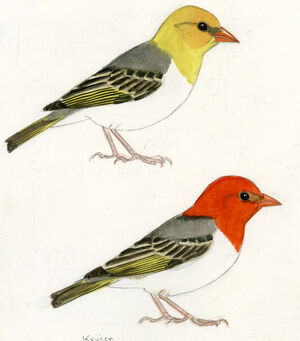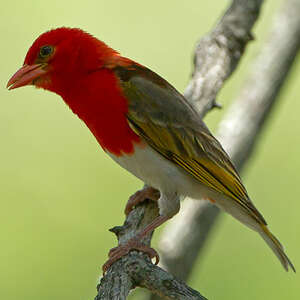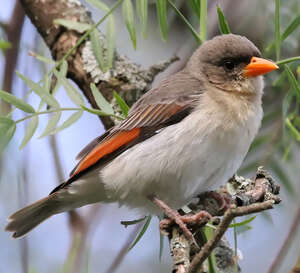Red-headed Weaver
Anaplectes rubriceps - Tisserin écarlate Anaplecte écarlate
Identification
The Red-headed Weaver male in breeding plumage is distinguished by the red colouring of all or part of its body. The one of the type subspecies in the south has a crimson head, with the lores simply black. The red extends to the chest, clearly separated from the drab whiteness of the rest of the underside. The mantle is red, edged with two black stripes forming a V. The wings and tail are grey-brown with the greater and median coverts edged in yellow. The rather long and thin bill is entirely reddish-orange. The iris is dark brown-red. The legs are flesh-coloured. The inter-breeding male, without red, resembles the female. The head, neck and upper chest are yellow, the former slightly dappled with gold-brown. The upperparts are grey-brown. The wings and rectrices remain unchanged, as do the underparts. Scattered orange feathers may be seen on the crown and breast. The bill is a pale horn-colour. The female plumage is identical to that of the inter-breeding male but brighter yellow in the front of the body. The juvenile resembles the female, only paler, with a tinge of brown on the forehead and underparts, and olive on the upperparts. The bill is grey. Several subspecies have been described, but only 3 are now accepted, including the type subspecies rubriceps in the south described above. In the north, A. r. leuconotos, the male has a large black mask around the eyes extending down onto the cheeks. There is less red on the mantle. Both sexes are greyer above than the other subspecies, lacking the yellow tints. The greater, lesser and median coverts are bordered in red, not yellow.Male A. r. jubaensis is distinctive with an entirely red body, red edges to the wing and tail feathers, and black edges to the scapulars.
Subspecific information 2 subspecies
- Anaplectes rubriceps rubriceps (Angola to s Tanzania and south to Botswana and ne South Africa)
- Anaplectes rubriceps leuconotos (s Mali to nc Nigeria and east to s Sudan and w Ethiopia, south to Tanzania, n Zambia and n Malawi)
Foreign names
- Tisserin écarlate,
- Tejedor cabecirrojo sureño,
- tecelão-de-cabeça-vermelha,
- Scharlachweber,
- skarlát szövőmadár,
- Scharlaken Wever,
- Tessitore testarossa,
- scharlakansvävare,
- Rødhodevever,
- pletiarka červenohlavá,
- snovač červenohlavý,
- Skarlagenvæver,
- punakaapukutoja,
- Rooikopwewer,
- teixidor cap-roig,
- wikłacz czerwonogłowy,
- Краснокрылый малимбус,
- アカガシラモリハタオリ,
- 红头编织雀,
- scharlakansvävare,
- 紅頭織布鳥,
Voice song and call
Habitat
The Red-headed Weaver is a woodland bird, living in a wide variety of forested habitats, including acacia savannas, wide-leafed deciduous forests, Brachystegia, Mopane, Burkea scrubland, riverine forests, as well as parks, gardens, and agricultural areas with trees, generally below 1,600 meters. A habitat may be abandoned if it becomes inhospitable, for example during the dry season.
Behaviour character trait
The Red-headed Weaver lives in couples or small groups but in search for food, it commonly joins other bird species, depending on the regions. The species is reputed to be sedentary and bird rings control prove it. For instance, a 9-year old bird has been controlled less than 5 km from its marking place in Zimbabwe. Nevertheless, some vagrancy can be observed, especially due to the climate constraints.
Dietfeeding habits
The Red-headed Weaver is mainly insectivorous. It looks for food in trees, under leaves, along branches at a height of 7 to 8 meters above the ground and on the associated lianas. It adopts adapted postures, for example by hanging from its legs. It also hunts flying insects. It eats Hemiptera, Coleoptera, Mantids, Termites as well as spiders which it takes directly from their webs. Small mollusks are mostly taken to feed the young. Seeds, fruits and berries are also part of its diet.
Reproduction nesting
The breeding season of the Red-headed Weaver varies depending on the region, from September to February for southern rubriceps, and practically all year round for leuconotos, whose range has a large latitudinal amplitude. Couples can nest alone, as seems to be the most frequent case with leuconotos. In contrast, with rubriceps, they mostly form small colonies, typically of about ten nests. A colony of 210 nests in northwest South Africa remains an exception. Colonial nesting favors polygamy, which is frequent in the colonies. The male is in charge of building the nest over a period of two to three weeks.
He will build, near this first nest and during the following two months, up to four additional nests, rarely five. The upside-down bottle-shaped nest has a long access tunnel pointing down. It was originally built in trees, suspended by a few twigs under the canopy, including in baobabs, and also in climbing vegetation between 1.5 and 15 meters high. Nests can be seen built on artificial structures such as poles or electrical/telephone lines, thatch edges and even inside constructions. The use of large raptor areas, such as the Banded Eagle, as nest support is frequently observed. This must provide protection against certain predators such as the Shikra. The nest is composed of textile plant elements, flexible twigs, thin stems, grass, linear or not leaves, which the male can easily interweave. Once a female has adopted it, she lines its inside with bark, fibers, feathers, dry grass or leaves. Then she lays 2 to 4 eggs, usually 3, blue in color, which she incubates mainly alone for 12 to 13 days, even though the male may rarely take her place.The chicks are fed by both adults but mainly by the female. The adults bring other animal prey besides insects to feed their young, such as small mollusks. The juveniles leave the nest at around 17 days. The species can be parasitized by the Eurasian Cuckoo. The old nests can be reused if they are in good condition. They can also be used by other bird species, notably the Cut-throat Finch, the Bright-rumped Warbler, and more occasionally the Southern Masked Weaver or the African Pied Wagtail.Geographic range
The Red-headed Weaver is found in a large part of sub-Saharan Africa with a distinct eastern center. To the north, the area of the ssp leuconotos is split into two. To the west, it forms a narrow infra-Saharan strip from southern Mali to southern Nigeria. To the east, it stretches from Eritrea to northern Zambia and Malawi, covering Ethiopia and Tanzania without reaching the Pacific Ocean. The area of ssp jubaensis is restricted to a small nucleus in southern Somalia and extreme east Kenya. Finally, the area of ssp rubriceps is partially sympatric with that of leuconotos. It extends widely from southern Tanzania and DRC to northern Botswana and South Africa, reaching the ocean in Mozambique which it covers totally. A distinct nucleus is observed in Angola, as well as an extension to the west through southern Angola and northern Namibia, which does not reach the Atlantic. The south of the continent is unoccupied.
Threats - protection
IUCN conservation status
concern
in the Wild
threatened
evaluated
The wide African distribution of the Red-headed Weaver means that it is not currently threatened at a continental level. It can be very common in some regions such as Angola or in the east of its range. Malawi has large populations which now seem confined to reserves. Kruger National Park is thought to harbour more than 16,000 individuals, while the centre and south of Mozambique have more than 30,000. It is classified as a species of least concern.
Sources of information
- IOC World Bird List (v15.1), Gill, F and D Donsker (Eds). 2025-12-07.
- Hanbook of the birds of the world - Vol 15, del Hoyo J., Elliott A. Christie D.
- Birds of the Horn of Africa, Nigel Redman
- HBW Alive,
- Biodiversity explorer The web of life in Southern Africa,
Other sources of interest
 Specification sheet created on
19/07/2023 by Nathalie Santa Maria
Specification sheet created on
19/07/2023 by Nathalie Santa MariaTranslation by AI Oiseaux.net
© 1996-2025 Oiseaux.net
- Accipitriformes
- Aegotheliformes
- Anseriformes
- Apodiformes
- Apterygiformes
- Bucerotiformes
- Caprimulgiformes
- Cariamiformes
- Casuariiformes
- Charadriiformes
- Ciconiiformes
- Coliiformes
- Columbiformes
- Coraciiformes
- Cuculiformes
- Eurypygiformes
- Falconiformes
- Galliformes
- Gaviiformes
- Gruiformes
- Leptosomiformes
- Mesitornithiformes
- Musophagiformes
- Nyctibiiformes
- Opisthocomiformes
- Otidiformes
- Passeriformes
- Pelecaniformes
- Phaethontiformes
- Phoenicopteriformes
- Piciformes
- Podargiformes
- Podicipediformes
- Procellariiformes
- Psittaciformes
- Pterocliformes
- Rheiformes
- Sphenisciformes
- Steatornithiformes
- Strigiformes
- Struthioniformes
- Suliformes
- Tinamiformes
- Trogoniformes





























